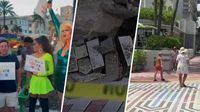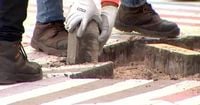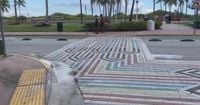On the evening of October 5, 2025, the colorful bricks of Miami Beach’s iconic rainbow crosswalk on Ocean Drive were pried up and replaced with black pavement, marking the end of a symbol that had come to embody pride, resilience, and inclusion for the city’s LGBTQ+ community and its allies. The removal, executed by Florida Department of Transportation (FDOT) crews using heavy machinery and sledgehammers, unfolded before a stunned crowd of beachgoers, residents, drag performers, and business owners—many of whom had long considered the crosswalk a landmark in Miami Beach’s historic Art Deco District.
The operation, which began suddenly and without advance notice to city officials, was the culmination of months of escalating tension between Miami Beach and the state government. The FDOT, acting under the direction of Governor Ron DeSantis, had ordered the removal of rainbow crosswalks and other street art from 400 locations across Florida, citing concerns over public safety and driver distraction. Cities such as Delray Beach, Key West, and Miami Beach were given a September deadline to comply or risk losing crucial state transportation funding.
Miami Beach, however, had resisted. Just a day before the original September 4 deadline, the city commission voted not only to keep the crosswalk but also to rename the stretch of Ocean Drive where it lay as Pride Street, hoping to cement its permanence. According to the Miami Herald, the crosswalk, designed by Savino Miller studio, featured terrazzo pavers arranged in a vibrant Art Deco pattern at the intersection of Ocean Drive and 12th Street—a location that had become synonymous with community celebration and protest alike.
But after the city lost its appeal to retain the sidewalk, FDOT moved in. The removal was swift and, for many, jarring. "All of a sudden all these FDOT trucks showed up, an army of workers, heavy machinery. No notice to our city," Commissioner Alex Fernandez told NBC Miami. Fernandez, who joined more than a dozen demonstrators holding signs and chanting "Miami Beach, forever proud," described the crosswalk as more than just colored bricks. "This is the story of people’s lives. Who’ve suffered decades of injustice, of inequality, of discrimination. Then we overcame that. That was the story being told by these bricks. We can’t lose that."
The emotional toll of the removal was palpable among those who had fought to keep the crosswalk. Drag artist CC Glitzer told WPLG Local10, "Our pride is getting erased just like that. It’s very painful." Performer TP Lourdes echoed the sentiment, saying, "This represents blood, sweat, and tears. It tears my heart to see it go." For many, the crosswalk was not just a traffic marker but a stage, a gathering place, and a testament to the community’s perseverance through adversity. Palace Bar owner Tom Donall, whose establishment sits near the intersection, recalled the effort it took to install the crosswalk and the meaning it held for his patrons and performers.
As the pavers came up, a crowd gathered. Some shouted in frustration at the workers—"Put a mask on so nobody sees who you are! You’re ashamed!" one man called out, according to the Miami Herald. Others hung rainbow flags above the intersection in a last-minute protest, determined to show that while the crosswalk might be gone, the spirit of Pride would remain. Jaminha Piazzetta, a longtime resident and tour guide, described the shock: "We were like, 'No, no, no,'" she said. "It hurts... I was with four people. I was telling the history and suddenly the trucks arrived."
FDOT’s justification for the removals has centered on safety. The department maintains that rainbow crosswalks and other pavement art can be distracting to drivers and that uniformity across the state’s roadways is essential. In a statement referenced by WSVN, FDOT explained that the removals were not limited to LGBTQ+ symbols, but extended to any street art associated with social, political, or ideological messages. Governor DeSantis has emphasized that crews have removed street art from all sides of the political spectrum, suggesting a policy of neutrality rather than targeted discrimination.
Yet, for many in Miami Beach and beyond, the loss of the rainbow crosswalk feels deeply personal. Resident Henry Stolar called the removal "a terrible abuse of power," pointing to the LGBTQ+ community’s longstanding contributions to the city. The crosswalk had stood not just as a symbol of Pride, but as a reminder of the struggles faced by marginalized groups and the progress made in recent decades. As Fernandez told NBC Miami, "You can strip away the crosswalk, you won’t strip away the values that run in the people of Miami Beach."
The controversy in Miami Beach is not unique. FDOT’s directive has led to the removal of rainbow crosswalks in other Florida cities, including outside the site of the 2016 Pulse nightclub massacre in Orlando—a location with its own profound significance for the LGBTQ+ community. In Delray Beach, similar murals were painted over, sometimes in the dead of night, sparking protests and legal debates over the boundaries of state authority and local expression.
Despite the heartbreak, there is a sense of determination among Miami Beach’s residents and leaders. Commissioner Fernandez has expressed hope that the bricks removed from the crosswalk can be collected and repurposed, preserving at least a piece of the history that unfolded at the intersection of Ocean Drive and 12th Street. Drag performer TP Lourdes, reflecting on the resilience of the community, said, "They might take this away, but they didn’t take the love and memories we’ve built here."
The removal of Miami Beach’s rainbow crosswalk has sparked debate about the balance between public safety, state oversight, and the right of local communities to express their identity and values. While the bricks may be gone, the conversations—and the pride—remain very much alive on the streets of Miami Beach.



